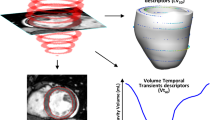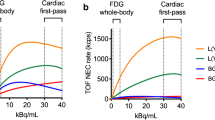Abstract
Background
Cardiovascular magnetic resonance (CMR) is the gold standard for the quantitative assessment of cardiac volumes, mass and function. There are, however, various strategies for establishing endocardial borders, the cardiac phase used for measurements and the body dimensions used for indexing these results. The aim of the study was to assess the impact of different strategies on reference values.
Methods and results
362 healthy volunteers (190 men, mean age 51 ± 13 years) underwent a standard CMR protocol. Left ventricular end-diastolic (LV-EDV) and end-systolic (LV-ESV) volumes and LV mass (LV-M) were measured at end systole and end diastole in SSFP sequences using two methods, one of which included papillary muscles and trabecular tissue in the LV-M (“include” approach), while the other excluded this tissue (“exclude” approach). There was a strong correlation between the results for LV volumes and LV ejection fraction (LV-EF) between the “include” and the “exclude” approach, while the mean values were different: LV-EDV: 149.7 ± 32.5 ml vs 160.5 ± 35.0 ml, p < 0.0001; LV-ESV: 48.7 ± 14.5 ml vs 56.4 ± 16.7 ml, p < 0.0001; LV-EF: 67.7 ± 5.4% vs 65.1 ± 5.6%, p < 0.0001. When comparing end-systolic with end-diastolic data, values for LV-M were significantly higher in end systole irrespective of whether papillary muscles and trabecular tissues were included or not. Furthermore, LV-M missed overweight-induced LV hypertrophy when indexed to body surface area (BSA) instead of height.
Conclusion
Quantitative assessment of LV volumes and mass with inclusion of papillary muscles and trabeculae to myocardial mass resulted in significantly different values, while indexing to BSA and not height may miss LV hypertrophy in terms of overweight.












Similar content being viewed by others
Abbreviations
- CMR:
-
Cardiovascular magnetic resonance
- LV:
-
Left ventricular
- RV:
-
Right ventricular
- LV-EDV:
-
Left ventricular end-diastolic volume
- LV-ESV:
-
Left ventricular end-systolic volume
- RV-EDV:
-
Right ventricular enddiastolic volume
- RV-ESV:
-
Right ventricular endsystolic volume
- LV-EF:
-
Left ventricular ejection fraction
- LV-M:
-
LV mass
- BSA:
-
Body surface area
- SSFP:
-
Steady-state free precession
- SD:
-
Standard deviation
- FIG:
-
Figure
References
Grothues F, Smith GC, Moon JC, Bellenger NG, Collins P, Klein HU, Pennell DJ (2002) Comparison of interstudy reproducibility of cardiovascular magnetic resonance with two-dimensional echocardiography in normal subjects and in patients with heart failure or left ventricular hypertrophy. Am J Cardiol 90:29–34
Bellenger NG, Grothues F, Smith GC, Pennell DJ (2000) Quantification of right and left ventricular function by cardiovascular magnetic resonance. Herz 25:392–399
Fieno DS, Jaffe WC, Simonetti OP, Judd RM, Finn JP (2002) TrueFISP: assessment of accuracy for measurement of left ventricular mass in an animal model. J Magn Reson Imaging 15:526–531
Pennell DJ (2010) Cardiovascular magnetic resonance. Circulation 121:692–705
Pennell DJ (2003) Cardiovascular magnetic resonance: twenty-first century solutions in cardiology. Clin Med (Lond) 3:273–278
Buckert D, Kelle S, Buss S, Korosoglou G, Gebker R, Birkemeyer R, Rottbauer W et al (2017) Left ventricular ejection fraction and presence of myocardial necrosis assessed by cardiac magnetic resonance imaging correctly risk stratify patients with stable coronary artery disease: a multi-center all-comers trial. Clin Res Cardiol 106:219–229
Radunski UK, Lund GK, Saring D, Bohnen S, Stehning C, Schnackenburg B, Avanesov M et al (2017) T1 and T2 mapping cardiovascular magnetic resonance imaging techniques reveal unapparent myocardial injury in patients with myocarditis. Clin Res Cardiol 106:10–17
Bietenbeck M, Florian A, Shomanova Z, Meier C, Yilmaz A. Reduced global myocardial perfusion reserve in DCM and HCM patients assessed by CMR-based velocity-encoded coronary sinus flow measurements and first-pass perfusion imaging. Clin Res Cardiol 2018
Stiermaier T, Poss J, Eitel C, de Waha S, Fuernau G, Desch S, Thiele H et al. Impact of left ventricular hypertrophy on myocardial injury in patients with ST-segment elevation myocardial infarction. Clin Res Cardiol 2018
Suinesiaputra A, Bluemke DA, Cowan BR, Friedrich MG, Kramer CM, Kwong R, Plein S et al (2015) Quantification of LV function and mass by cardiovascular magnetic resonance: multi-center variability and consensus contours. J Cardiovasc Magn Reson 17:63
Schulz-Menger J, Bluemke DA, Bremerich J, Flamm SD, Fogel MA, Friedrich MG, Kim RJ et al (2013) Standardized image interpretation and post processing in cardiovascular magnetic resonance: Society for Cardiovascular Magnetic Resonance (SCMR) board of trustees task force on standardized post processing. J Cardiovasc Magn Reson 15:35
Childs H, Ma L, Ma M, Clarke J, Cocker M, Green J, Strohm O et al (2011) Comparison of long and short axis quantification of left ventricular volume parameters by cardiovascular magnetic resonance, with ex-vivo validation. J Cardiovasc Magn Reson 13:40
Codella NC, Lee HY, Fieno DS, Chen DW, Hurtado-Rua S, Kochar M, Finn JP et al (2012) Improved left ventricular mass quantification with partial voxel interpolation: in vivo and necropsy validation of a novel cardiac MRI segmentation algorithm. Circ Cardiovasc Imaging 5:137–146
Janik M, Cham MD, Ross MI, Wang Y, Codella N, Min JK, Prince MR et al (2008) Effects of papillary muscles and trabeculae on left ventricular quantification: increased impact of methodological variability in patients with left ventricular hypertrophy. J Hypertens 26:1677–1685
Kozor R, Callaghan F, Tchan M, Hamilton-Craig C, Figtree GA, Grieve SM (2015) A disproportionate contribution of papillary muscles and trabeculations to total left ventricular mass makes choice of cardiovascular magnetic resonance analysis technique critical in Fabry disease. J Cardiovasc Magn Reson 17:22
Kawaji K, Codella NC, Prince MR, Chu CW, Shakoor A, LaBounty TM, Min JK et al (2009) Automated segmentation of routine clinical cardiac magnetic resonance imaging for assessment of left ventricular diastolic dysfunction. Circ Cardiovasc Imaging 2:476–484
de Simone G, Daniels SR, Devereux RB, Meyer RA, Roman MJ, de Divitiis O, Alderman MH (1992) Left ventricular mass and body size in normotensive children and adults: assessment of allometric relations and impact of overweight. J Am Coll Cardiol 20:1251–1260
Palmieri V, de Simone G, Arnett DK, Bella JN, Kitzman DW, Oberman A, Hopkins PN et al (2001) Relation of various degrees of body mass index in patients with systemic hypertension to left ventricular mass, cardiac output, and peripheral resistance (The Hypertension Genetic Epidemiology Network Study). Am J Cardiol 88:1163–1168
Shah RV, Murthy VL, Abbasi SA, Eng J, Wu C, Ouyang P, Kwong RY et al (2015) Weight loss and progressive left ventricular remodelling: the multi-ethnic study of atherosclerosis (MESA). Eur J Prev Cardiol 22:1408–1418
Friberg P, Allansdotter-Johnsson A, Ambring A, Ahl R, Arheden H, Framme J, Johansson A et al (2004) Increased left ventricular mass in obese adolescents. Eur Heart J 25:987–992
Tribouilloy C, Bohbot Y, Marechaux S, Debry N, Delpierre Q, Peltier M, Diouf M et al (2016) Outcome implication of aortic valve area normalized to body size in asymptomatic aortic stenosis. Circ Cardiovasc Imaging 9
Sawyer M, Ratain MJ (2001) Body surface area as a determinant of pharmacokinetics and drug dosing. Invest New Drugs 19:171–177
D’Errico L, Lamacie MM, Jimenez Juan L, Deva D, Wald RM, Ley S, Hanneman K et al (2016) Effects of slice orientation on reproducibility of sequential assessment of right ventricular volumes and ejection fraction: short-axis vs transverse SSFP cine cardiovascular magnetic resonance. J Cardiovasc Magn Reson 18:60
Rider OJ, Francis JM, Ali MK, Byrne J, Clarke K, Neubauer S, Petersen SE (2009) Determinants of left ventricular mass in obesity; a cardiovascular magnetic resonance study. J Cardiovasc Magn Reson 11:9
Acknowledgements
We thank our technologists Daniel Helm, Melanie Feiner, Miriam Hess and Leonie Siegmund for image acquisition.
Funding
None.
Author information
Authors and Affiliations
Contributions
JR—drafting of the manuscript, acquisition and analysis of data, interpretation of data. KS—drafting of the manuscript, analysis and interpretation of data. FA—acquisition of data, analysis and interpretation of data. MO—acquisition of data, revising the manuscript critically for important intellectual content. KH—acquisition of data, revising the manuscript critically for important intellectual content. ES—acquisition of data, revising the manuscript critically for important intellectual content. TF—analysis of data, revising the manuscript critically for important intellectual content. MM—acquisition of data, revising the manuscript critically for important intellectual content. EG—analysis and interpretation of data, revising the manuscript critically for important intellectual content. HK—drafting of the manuscript, final approval of the manuscript submitted. MF—drafting of the manuscript, conception and design, analysis and interpretation of data.
Corresponding author
Ethics declarations
Conflict of interest
Matthias G. Friedrich is advisor, board member and shareholder of Circle Cardiovascular Imaging Inc., Calgary.
Ethics approval
The study was approved by the local ethics committee (Ethikkommission Medizinische Fakultät Heidelberg (S038-2007)).
Consent for publication
Not applicable.
Availability of data and materials
The datasets used and/or analyzed during the current study are available from the corresponding author on reasonable request.
Electronic supplementary material
Below is the link to the electronic supplementary material.
Rights and permissions
About this article
Cite this article
Riffel, J.H., Schmucker, K., Andre, F. et al. Cardiovascular magnetic resonance of cardiac morphology and function: impact of different strategies of contour drawing and indexing. Clin Res Cardiol 108, 411–429 (2019). https://doi.org/10.1007/s00392-018-1371-7
Received:
Accepted:
Published:
Issue Date:
DOI: https://doi.org/10.1007/s00392-018-1371-7




